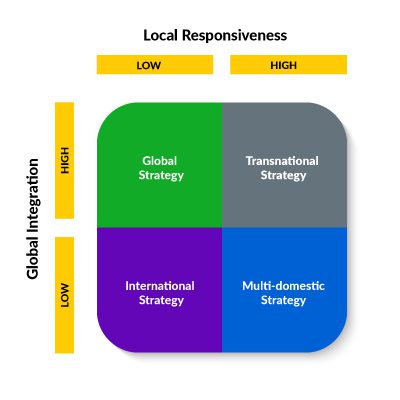




Companies looking to go global must determine which international business strategy is best for their business. We’ve already talked about multidomestic, global, and transnational strategies.
All of these global strategies require different levels of local responsiveness, global integration, standardization, and customization:

An international strategy allows companies to expand into global markets by selling existing products or services with minimal customization. This method is low in local responsiveness and low in global integration, making it a cost-effective way to reach international audiences while maintaining a centralized business approach.
Companies that implement an international expansion strategy can benefit from:
Since 76% of online consumers prefer to purchase from websites in their native language (CSA Research), businesses often find that simply translating their website can be a cost-effective global expansion strategy with minimal investment. That is why international strategies tend to be the first corporate strategy used for new market expansion.
An international strategy is a great first step to global expansion because it requires minimal operational changes. Instead of fully localizing operations, businesses export existing products and services while maintaining brand consistency.
Many companies will find that all it takes to launch an international strategy is website translation and localization. Investing in the best website translation services is a cost-effective way to get your business site in front of new audiences with very little effort.
An international strategy can become an extension of a business' existing domestic strategy. This means businesses can centralize global operations and brand decisions without investing in global expansion. However, there are some challenges that come along with this process.
However, challenges exist, including website translation, legal compliance, customer service across time zones, and generating awareness in new markets.
A well-structured international growth strategy enables businesses to scale efficiently. Multinational enterprises can leverage the benefits of standardization to instantly expand their market reach at low costs. They operate at a high level of communication, knowledge, and productivity to meet strategic objectives across various markets.
Understand cultural and language differences. Website localization services will understand different dialects with differing meanings tied to the exact words.
Assess the local economy. Determine if pricing structures allow your business to compete effectively.
Identify your target audience. Understand consumer behaviors to ensure demand for your product or service.
Evaluate global integration needs. Find the right balance between standardization and localization. Look for product-market fits that require minimal local responsiveness and global integration.
Select the best translation approach. A partner like MotionPoint offers many different options for translation solutions.
It's crucial to understand how the strategies that may have worked in one market (or company) may not be successful in another. The more agile and receptive you are to buyer tendencies in different regions, the faster you can implement changes.
One of the fastest and most cost-effective ways to implement an international strategy is through website translation and localization. A concierge-level translation and localization partner can help you through the process. Companies investing in multilingual digital experiences see 1.5x higher conversion rates in international markets.
A high-quality website translation and localization solution ensures that your website is culturally adapted and optimized for international audiences. MotionPoint's Adaptive Translation™ technology helps businesses:
Developing an international strategy is essential for companies looking to increase global market share and expand efficiently. Website translation and localization offer a strategic, low-risk approach to reaching new audiences and boosting revenue.
To learn more about how MotionPoint’s Adaptive Translation™ solutions can support your global expansion, visit our website today!